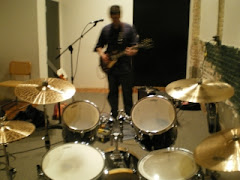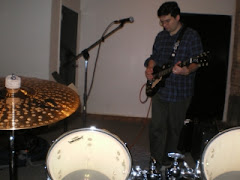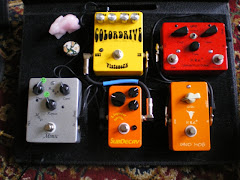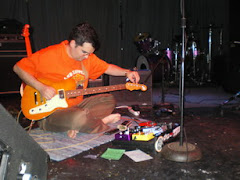
A part of me had to get over what seemed like the basic ridiculousness of the drums. What drumming boils down to is a stick hitting a rock. The primitiveness of that idea – and the complementary idea that only boys hits things with sticks was one of those ideas I had to get over to learn how to play them. The violin, which I had grown up playing, was a gentle instrument, refined over centuries, ethereal. The drums, on the other hand, is this: a stick hitting a surface. The good side of that is anyone can come to the drums and make a sound – a decent sound. That’s hard to say about the violin. It takes a fair amount of training and practice just to get a sound. The bad side? The drums seem easier to learn than they are. A drum teacher told me once and I realized it later myself, that it’s a lot harder than it looks to become a good drummer. A person can get through a song bashing at the drums, but to be really good at it takes time and practice.
From the moment I got my first drum kit, a late eighties, forest green Tama Rhythm-mate, I was intimated. It was almost too simple. And yet, I couldn’t even put it together by myself. That would be the first dichotomy I would learn about the drums: it’s so easy, it’s hard. Thankfully, Brian knew about drum set-up from the bands he had been in and the drummers in them. Andy, the drummer of Brian’s band in
That brings me to another dynamic of learning how to play the drums – the lingo. There’s a few terms that only gigging musicians know and while I had been living with a musician for 4 years and had heard the terms before, as I began to play and gig myself I heard myself utter specialized lingo with the same casual manner that I would have previously said things like “I’m going to the bathroom” or “Have you seen my keys?”
Now, my everyday conversation includes phrases like: “Can you help me load up the gear?”, “Who’s doing the backline?”, and our personal gig favorite “I need more mids in my monitors.”
The terminology is something I learned in context, gradually, as if I was learning Italian or Swedish. When we set-up for a show at a bar, the Sound Guy (usually a guy – although we’ve had Sound Girls twice) appears and asks:
“How many vocals you need?”
“One,” we say.
And we do sound check – another term meant to designate that period before the show when the sound guy/girl listens to you play and sets the “levels” – another term for setting the bass and treble – essentially the sound of the music. Setting “levels” is much like adjusting the equalizer on your car stereo. With each gig I learned more of the language that made me less a novice and more…well, I wouldn’t say “pro”, how about “experienced”? Understanding what was going around me during the set-up of a show also helped me feel more confident about actually playing the show. I don’t start the night by being baffled so I don’t end it that way either…well, most of the time, anyway. My confidence these days has risen so that I remember to learn the names of the men and women “who run the board” (that’s more lingo for Sound Guy) and also to show them the due respect. I’ve also learned that no matter how well we play, if the P.A. and the sound isn’t working, it won’t matter. My confidence is also good enough that on stage I’m as comfortable speaking to the Sound Guy as I am speaking to Brian, but that too was another journey.
As I learned to play I learned to step away from ideas about drumming that had stereotyped it and hence, made it inaccessible to me. I stepped away from the idea that it was for boys, especially young ones, or for teen-agers. I also stepped away from the idea that it was primitive. The more I learned to play and the more I listened to great drummers, the more I could feel the emotional content of drumming. And as I practiced on my rubber practice pad in the extra bedroom next to the closet with the litter boxes the more I began to appreciate the subtlety of an instrument that, at first glances, seems to be about the not-subtle. When I hold a drum stick in my hand I don’t feel the urge to hit things, rather, I feel now the grain in the wood, the gentle curve of stick as it sits on top of my fingers. I feel the weight of its tip as it hits the practice pad. I feel the muscles of my arm moving slightly and simply to adjust the sound. I feel my pinky finger adjust at the end of the stick and I realize that this hitting a surface with a stick is not an act of aggression, but expression. And as I sit upright and breathe and count, I move inward into myself and feel how that stick and I are part of the same universe and my expression is a feeling beyond me.
And then there are other days….
One-and-two-and-three-and-four-and..
Left-right-left-right
When it feels like I’m just hitting a rock with a stick.














1 comment:
Not stone -- skin! The drum is a something from which you pull sound, not beat it out.
Have you read Layne Redmond's When the Drummers Were Women? I highly recommend it. I finally got to take a workshop with her at the Kripalu Center in MA just recently. She's wonderful -- an amazing player, a real inspiration. Hand drumming not sticks (although we practice rhythms on plastic chopsticks!), but the process is much the same.
Post a Comment